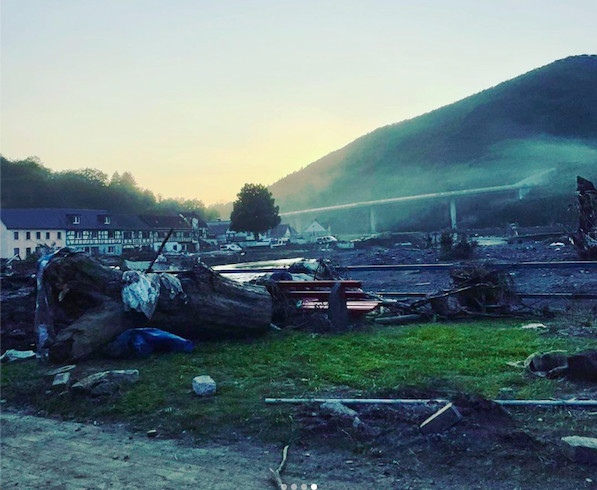
Long Read: Floods in the Ahr valley – A tale of destruction and solidarity
Large areas of Western Germany were flooded last week and are dealing with an unprecedented level of destruction and loss. The overall sense of bafflement and being overwhelmed has prompted an international movement of solidarity, namely within the wine community, eager to help fellow winemakers many of whom have lost all their cellared stock, equipment, homes and wineries. Whether the foundations of the latter are still sound is yet to be determined; as is, in most cases, whether insurances will cover the damage caused by this unexpected natural disaster.
A very specific set of meteorologic conditions caused the phenomenon: low-pressure zone ‘Bernd’ was flanked by high pressure areas to the east and west as it moved through Central Europe. Thus trapped, Bernd released all the moisture it had gathered in the Mediterranean in the form of torrential rains that lasted three days and, in some areas, yielded the equivalent to the average precipitation for the whole of July in just 24 hours. North Rhine-Westphalia, Rhineland-Palatinate, Bavaria and Saxony were the most affected states, reporting widespread infrastructural damage and, at the time of writing, 180 fatal casualties and over 1,000 injured.
Thousands remain without electricity and running water. The sense of dreary awe was palpable and visible on the faces of all those that, in a matter of hours, saw all their belongings being washed away.
The impact in winegrowing areas, particularly in the Ahr valley, has been no less than dramatic. A tributary of the Rhine, flowing about 75 miles North of the Middle Mosel, the Ahr is home to some of Germany’s finest expressions of Spätburgunder (Pinot Noir). As in other iconic German wine regions, most estates line the banks of its eponymous river and were, therefore, at the mercy of the deluge.
While it is yet impossible to accurately assess the damages, the proportion is shockingly apparent. Michael Lang, owner of the AhrWein Depot in Ahrweiller, posted a painfully clear video of the war-like devastation the picturesque village at the core of the valley endured.
There are wide calls for government support, but private initiatives took the lead. Retailers were quick to react, with the Schwarz Group (Lidl, Kaufland, Schwarz Produktion and PreZero) having promptly announced a €10M donation to affected communities.
The Verband Deutscher Prädikatsweingüter (VDP) has launched a fundraising campaign, hoping to provide easy and immediate help to the Ahr winemakers that, after losing their cellared stock, see the upcoming harvest at risk. The German Wine Institute (DWV) has also made an appeal for donations, pointing out that the winegrowers need urgent help both with clean-up operations and with the necessary vineyard work that cannot be postponed if the 2021 vintage is to be saved. At stake is the livelihood of many families and businesses, already under pressure after a year of stalling trade and tourism. Just as the crisis promised to come to an end, the unimaginable happened.
Winemakers in other regions are gathering resources to support their Ahr comrades; Karl-Josef Thul (Mosel) and Dirk Würtz (Rheinhessen) have spearheaded an effort to send equipment, people, material and wine (for fundraising auctions) to the Ahr.
Martin Sermann of Weingut Sermann, one of the estates directly affected by the floods, gives a vivid first-hand account of the tragedy: “After early warnings of intense rains and rising water levels, my father and brother started preparing themselves for the worst and moving the winery. But the true extent of the flood was never made clear, and it all proved useless. Waters rose to 9m when the usual level of the Ahr is 60 cm. The previous documented record is 3.17m.”
All their winemaking and bottling equipment is either irreversibly damaged or simply floated away. The biggest loss, both economic and emotional, are the barrels in which their most prized, expensive wines were ageing. Sermann estimates their value to be somewhere between €200-400k.
He envisions an extremely hard harvest ahead, with all the main infrastructures damaged. "Harvest in the Ahr is almost exclusively done by hand. It will be hard to transport and house all the workers we need.” He thinks, however, that the real challenge will arrive in the medium term. "The danger is the next two-three years, once all the media attention is gone and the infrastructure is not yet there again. Many winemakers depend on tourism and cellar-door sales and all that will be gone. Our region usually works with a whole-package offering which we won’t be able to provide. The medium term will be extremely challenging."
Even the rescue efforts are facing fundamental impediments due to macro-infrastructural damages, which in turn will impact wineries not directly affected by the floods. Roads, railroads, sewage, energy and communication networks have all been severely, if not irremediably, damaged and will take months, perhaps years, to be rebuilt. Logistics and supply chains will be deeply affected in the short and medium term and the rippling effects are yet to be fully understood.
Many have already called for a hard assessment, once waters have gone down, of what went wrong and could’ve been done better. Authorities have been targets of intense scrutiny and criticism for not having taken adequate action prior and during the torrential rains. The extent and speed of events suggests, however, that the main force at play is climate change, its consequences becoming ever more tangible and devastating. As Sermann pointed out, this tragedy is a call for action and climate change preparedness cannot be the remit of big corporations. Governments and smaller businesses, especially those such as wineries that rely on nature’s moods, need to be ready for the inevitable threats ahead.
Keywords:
- wine
- Germany
- climate change
- German Wine
- floods
- Verband Deutscher Prädikatsweingüter
- Vd
- Weingut Sermann
- natural disaster









